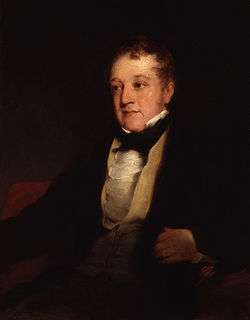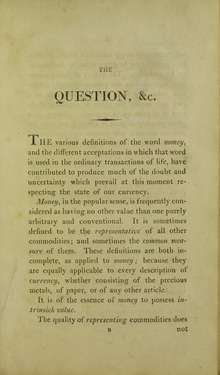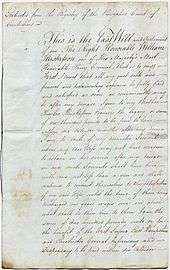William Huskisson
| The Right Honourable William Huskisson | |
|---|---|
 | |
| President of the Board of Trade | |
|
In office 21 February 1823 – 3 September 1827 | |
| Monarch | George IV |
| Prime Minister |
The Earl of Liverpool George Canning |
| Preceded by | Frederick John Robinson |
| Succeeded by | Charles Grant |
| Secretary of State for War and the Colonies | |
|
In office 3 September 1827 – 30 May 1828 | |
| Monarch | George IV |
| Prime Minister |
The Viscount Goderich The Duke of Wellington |
| Preceded by | The Viscount Goderich |
| Succeeded by | Sir George Murray |
| Leader of the House of Commons | |
|
In office 3 September 1827 – 26 January 1828 | |
| Monarch | George IV |
| Prime Minister | The Viscount Goderich |
| Preceded by | George Canning |
| Succeeded by | Robert Peel |
| Personal details | |
| Born |
11 March 1770 Birtsmorton Court, Malvern, Worcestershire |
| Died |
15 September 1830 (aged 60) Eccles, Lancashire |
| Nationality | British |
| Spouse(s) | Emily Milbanke (d. 1856) |
William Huskisson PC (11 March 1770 – 15 September 1830) was a British statesman, financier, and Member of Parliament for several constituencies, including Liverpool.[1]
He is best known as the world's first widely reported railway casualty as he was run over and fatally wounded by George Stephenson's pioneering locomotive engine Rocket.
Background and education
Huskisson was born at Birtsmorton Court, Malvern, Worcestershire, the son of William and Elizabeth Huskisson, both members of Staffordshire families. He was one of four brothers. After their mother Elizabeth died, their father William eventually remarried and had further children by his second wife.
Early life
Huskisson was a student at Appleby Grammar School (later renamed Sir John Moore Church of England Primary School), a boarding school designed by Sir Christopher Wren on the Leicestershire/Derbyshire borders. In 1783, Huskisson was sent to Paris to live with his maternal great-uncle Dr. Richard Gem, who was physician to the British embassy there. He remained in Paris until 1792, and his experience as an eyewitness to the prelude and beginning of the French Revolution gave him a lifelong interest in politics. Huskisson first came to public notice while still in Paris. As a supporter of the moderate party, he became a member of the "Club of 1789," which favoured making France into a constitutional monarchy. On 29 August 1790, he delivered a speech entitled "Sur les Assignats", about the issue of assignats by the French government. This speech gave him a reputation as an expert in finance. From 1790 to 1792, the Marquess of Stafford was the British ambassador to Paris. Huskisson became a protégé of the Marquess, and returned to London with him.
Political career

Once in London, Huskisson quickly gained an additional two powerful political patrons: Henry Dundas, the Home Secretary, and William Pitt the Younger, the Prime Minister. Because of Huskisson's fluency in French, Dundas appointed him in January 1793 to oversee the execution of the Aliens Act, which mostly dealt with French refugees. In the discharge of his delicate duties, he manifested such ability that in 1795 he was appointed Under-Secretary at War (the Secretary at War's deputy).
In the following year he entered parliament as member for Morpeth, but for a considerable period he took scarcely any part in the debates. In 1800 he inherited a fortune from Dr Gem. On the retirement of Pitt in 1801 he resigned office, and after contesting Dover unsuccessfully he withdrew for a time into private life. Having in 1804 been chosen to represent Liskeard, he was on the restoration of the Pitt ministry appointed secretary of the treasury, holding office till the dissolution of the ministry after the death of Pitt in January 1806.
After being elected for Harwich in 1807, he accepted the same office under the Duke of Portland, but he withdrew from the ministry along with Canning in 1809. In the following year he published a pamphlet on the currency system, which confirmed his reputation as the ablest financier of his time; but his free-trade principles did not accord with those of his party. In 1812 he was returned for Chichester.
When in 1814 he re-entered the public service, it was only as First Commissioner of Woods and Forests, but his influence was from this time very great in the commercial and financial legislation of the country. He took a prominent part in the corn-law debates of 1814 and 1815; and in 1819 he presented a memorandum to Lord Liverpool advocating a large reduction in the unfunded debt, and explaining a method for the resumption of cash payments, which was embodied in the act passed the same year. In 1821 he was a member of the committee appointed to inquire into the causes of the agricultural distress then prevailing, and the proposed relaxation of the corn laws embodied in the report was understood to have been chiefly due to his strenuous advocacy.
In 1823 he was appointed President of the Board of Trade and Treasurer of the Navy, and shortly afterwards he received a seat in the cabinet. In the same year he was returned for Liverpool as successor to Canning, and as the only man who could reconcile the Tory merchants to a free trade policy. Among the more important legislative changes with which he was principally connected were a reform of the Navigation Acts, admitting other nations to a full equality and reciprocity of shipping duties; the repeal of the labour laws; the introduction of a new sinking fund; the reduction of the duties on manufactures and on the importation of foreign goods, and the repeal of the quarantine duties.
As a pro-planter Secretary for Colonies in 1826, he proposed the revised Consolidated Slave Law which was accepted by Parliament.
In 1826 after the Power-loom riots, a number of manufacturers subsequently agreed to pay a standard rate to the weavers, but on their own admission it was a "starvation" wage. Those who stuck to the agreement found it difficult to compete with those manufacturers who did not, and could therefore undercut them, prompting an appeal to William Huskisson, the President of the Board of Trade, to introduce a legally binding minimum wage. Huskisson's response was dismissive, expressing his view that to introduce such a measure would be "a vain and hazardous attempt to impose the authority of the law between the labourer and his employer in regulating the demand for labour and the price to be paid for it".[2]
In accordance with his suggestion Canning in 1827 introduced a measure on the corn laws proposing the adoption of a sliding scale to regulate the amount of duty. A misapprehension between Huskisson and the Duke of Wellington led to the duke proposing an amendment, the success of which caused the abandonment of the measure by the government.
After the death of Canning in the same year Huskisson accepted the secretaryship of the colonies under Lord Goderich, an office which he continued to hold in the new cabinet formed by the Duke of Wellington in the following year. After succeeding with great difficulty in inducing the cabinet to agree to a compromise on the corn laws, Huskisson finally resigned office in May 1828 on account of a difference with his colleagues in regard to the disfranchisement of East Retford.
He was followed out of the government by other Tories who are usually described as Canningites including Lord Palmerston, Charles Grant, Lord Dudley, and Lord Melbourne.
Death


While attending the opening of the Liverpool and Manchester Railway, on 15 September 1830, Huskisson rode down the line in the same train as the Duke of Wellington, on the first of several trains moving in procession. At Parkside railway station, near the midpoint of the line, the locomotives made a scheduled stop to take on water. Although the railway staff had advised passengers to remain on the trains while this took place, around fifty of the dignitaries on board alighted when the Duke of Wellington's special train stopped. One of those who got off was Huskisson, who approached the Duke's railway carriage at the Duke's invitation and shook his hand. Distracted by Wellington, he did not notice the approaching locomotive Rocket on the adjacent track.
On realising his danger he panicked and tried to clamber into the Duke's carriage, but the door of the carriage swung open leaving him hanging directly in the path of the oncoming Rocket. He fell onto the tracks in front of the train.[3] His leg was horrifically mangled by the locomotive. After being told his death was imminent he made his will, and died a few hours later.[4]
The death and funeral of William Huskisson caused the opening of the railway to be widely reported, and people around the world became aware for the first time that cheap and rapid long-distance transport was now possible – and could be dangerous.
Family and commemorations
On 6 April 1799, Huskisson married Emily Milbanke, the youngest daughter of Admiral Mark Milbanke, the commander-in-chief at Portsmouth. Emily Huskisson survived her husband and remained a widow until her death in April 1856. They had no children. In 1800 Huskisson bought Eartham House in West Sussex from his friend William Hayley, and is commemorated in the parish church by a long carved eulogy from Emily on the south wall.
The monument where his remains are buried is the centrepiece of St James Cemetery, Liverpool.[5] A marble statue of him was housed in a mausoleum there until 1968, when it was transferred to the Walker Art Gallery in Liverpool.[6]
Emily also commissioned a second marble statue for the Custom House in Liverpool. This statue now stands in Pimlico Gardens in London. A bronze casting of it was unveiled at the Custom House in 1847, and after several moves is now in Duke Street in Liverpool city centre.[6]
- Eartham Church plaque erected by Huskisson's wife Emily
- Tablet that originally marked the site of the accident
- Inscription on the Chichester Cathedral statue
- Statue in Chichester Cathedral
 Huskisson monument, St James' Mount, Liverpool
Huskisson monument, St James' Mount, Liverpool
See also
- Lists of rail accidents
- Huskisson, New South Wales, a town named after William Huskisson
- List of statues and sculptures in Liverpool
- Consolidated Slave Law
References
- ↑ C. R. Fay, Huskisson and His Age (1951).
- ↑ Aspin 1995, p. 70
- ↑ The Death of William Huskisson
- ↑ Derail: Why Trains Crash by Nicholas Faith, page 44, publ 2000 by Channel 4 books, ISBN 0-7522-7165-2
- ↑ William Huskisson at HistoryHome.co.uk
- 1 2 Huskisson statue at National Museums website
-
 This article incorporates text from a publication now in the public domain: Chisholm, Hugh, ed. (1911). "article name needed". Encyclopædia Britannica (11th ed.). Cambridge University Press.
This article incorporates text from a publication now in the public domain: Chisholm, Hugh, ed. (1911). "article name needed". Encyclopædia Britannica (11th ed.). Cambridge University Press.
Bibliography
| Wikisource has the text of the 1885–1900 Dictionary of National Biography's article about Huskisson, William. |
| Wikisource has the text of the 1911 Encyclopædia Britannica article Huskisson, William. |
| Wikimedia Commons has media related to William Huskisson. |
- Brady, Alexander, William Huskisson and liberal reform; an essay on the changes in economic policy in the twenties of the nineteenth century, Oxford, OUP, 1928. (2nd ed. London, Cass, 1967).
- Fay, C. R., Huskisson and His Age. London : Longmans Green, 1951.
- Garfield, Simon, The Last Journey of William Huskisson. London: Faber, 2002. ISBN 0-571-21048-1
External links
- Hansard 1803–2005: contributions in Parliament by William Huskisson
- William Huskisson page on the Peel Web.
- Portraits of William Huskisson at the National Portrait Gallery, London

- A Piece of Lowton History has information about Huskisson's death and memorial.
.svg.png)